Training your dog to be a disc dog can be super fun. You can train your dog to catch a frisbee either to burn extra energy or to compete. Either way disc training can be a great way to bond with your dog. It's also fun for both of you!
Contents
When Should Disc Training Begin?
Training your puppy to be a disc dog can start as soon as you bring them home. Just be careful to keep sessions short and fun. Puppy growth plates don't close until they are about 18 months old. Doing too much jumping or too high jumping can cause damage to the growth plates. This can cause your puppy to grow weird with some legs longer than others or stunted growth. Careful training will avoid this. You can get an x-ray at your vet to know for sure that the plates are closed.
Choosing a small soft disc for a puppy is a good plan. Pick smaller discs for smaller pups.
If you are training an adult dog starting slow is a good idea too. This will help to avoid injury and help them build the muscle they need.
Develop a Bond, Drive, and Engagement
Your dog will not want to work with you if they don't like and trust you. This is why your bond with your dog is so important, not just for disc dog training but for all training. To develop a strong bond it is best to implement positive reinforcement training strategies and to try to understand your dog as much as possible
Before starting a training session have a plan in mind so you don't waste time. Set your dog up for success, don't push them too hard too fast. It is a good idea to always stop a training session on a positive note and to stop when your dog is still having fun before he is exhausted. Keep the sessions short and very positive, go wild with praise when the pup does something right.
It can be helpful to know a few calming signals so that you can read your dog's body language. If you note him yawning, licking his lips, or looking away from you he might be stressed and need a break.
To keep your dog engaged you need to be the most interesting around, not the other dogs, smells, or that butterfly going by. Being spontaneous can be hugely important for keeping your dogs interest. Another way to be interesting is to reward your dog for looking at you when you aren't even asking them too. This can help teach your dog to check in with you and give you his attention.
Bite Work/Tug Training
Disc dogs need strong jaws to grab and hold the flying disc. That is why it is so important to develop your pups bite. Just to be clear, bite is for toys and discs, not people or other animals. A quick and fun game that enhances bite is tug. Start with two, soft frisbees. Tug with the pup for a bit and let him win! Then offer the dog the other frisbee and start again. Let the pup win every time.
Chase
In order to be a good disc dog, your pup will need to chase down the frisbee. So, teaching chase is important. You can do this by tying a favorite toy to a rope and dragging it around the house and yard for the pup to catch. Be sure to let the pup catch the item every time, encourage them to chase the item and praise them when they get it. After the pup has learned to chase, you can introduce "rollers." This is where you roll the frisbee over short distances on its side. This will help the pup learn how to grab the frisbee. You could then call the pup back for a second frisbee as in the tug training above to keep the game going.
Tricks/Movement
It can also be helpful to teach your pup different tricks that will help them build muscle memory for things that he may do while chasing discs. Here are a few examples, start the training with treats and then move to the disc as the reward:
Running between your legs, both directions
Running around you in both directions
Have you puppy jump through arm hoops, front and back, and on both sides.
Leg weaving is a good thing to teach too.
Teach your dog so spin clockwise and counter-clockwise.
Beg and standing on their hind legs is helpful too.
Doing ladder work or trot poles can help your dog develop an awareness of their hind end.
Also, balance work on a ball, peanut, or another inflated surface can be helpful.
Just be sure to keep training fun and short. You can make the moves more complex as your dog gets older and more experienced.
Drop
This is helpful to get the dog to drop the disc after they have it and avoid sessions of keep-away. The tug training is pretty handy for this. When you offer the second disc simple say "drop" before the pup drops the first frisbee. Reward the pup with the second frisbee and some praise.
Catch
This is an essential skill for a disc dog to have. To teach it, when you are feeding your dog get his attention and give him the command to "catch" then toss a piece of food up in the air. This exercise will help to increase your pup's eye/mouth coordination. After your pup masters this you can try "catch" with a disc.
Take
This exercise will help your dog with grabbing the disc while it is in a position similar to where it will be while flying through the air. Hold the disc in your hand in front of and slightly above your dog. Instruct them to "take" the disc and let them have it with lots of praise. Go back and forth with several discs. Eventually, you can begin to drop the disc as you say "take" and the pup will actually take the disc out of the air. Once the pup masters this, start tossing the disc a few inches for the pup to take. Increase distance slowly once the pup succeeds at each distance.
Practice
Not only do you need to practice with your pup you must practice your throwing and rolling skills. If you don't throw or roll well your dog won't be able to succeed as well. Have fun training!

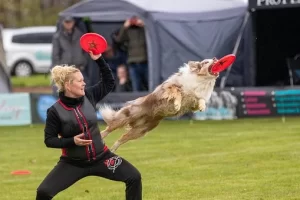
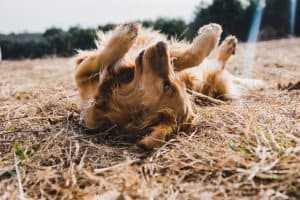
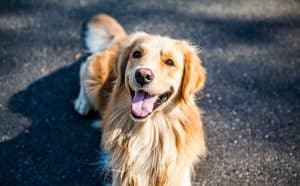
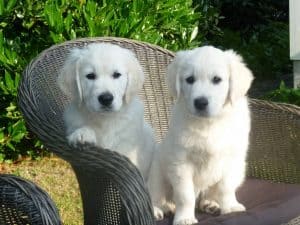
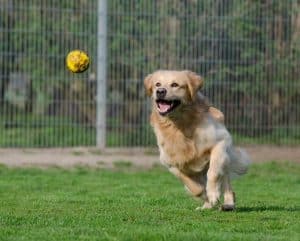
Leave a Reply
You must be logged in to post a comment.